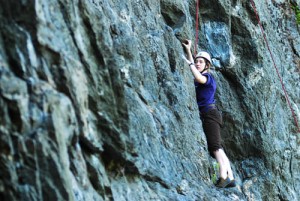We get on airplanes, trains and cars to travel to vacation spots, business affairs and to see family and friends. Either we are going to bottom of the map for some sunshine and cool breezes or to the top of it for the snow and mountains. With both, you can experience some type of sickness from the climate changes. Generally we become a candidate for a climate change sickness such as going from a hot, dry day to a rain shower that cools down the temperature and vice versa. But there is a more extreme climate related sickness you can experience going to a place that is higher above sea level. It is called Altitude sickness.
Altitude sickness can occur while you are mountain biking, sking, snowboarding, and rock climbing. It can ruin your whole trip so knowing how to prevent and treat this condition is important!
What is Altitude Sickness?
Altitude sickness is an uncomfortable and potentially serious condition that affects some people when they travel to high-altitude destinations such as Aspen, Colorado, and Machu Picchu. Basically any area that is mountainous will put you at a high risk of getting this sickness.
Generally, altitude sickness strikes more than 60 percent of people who ascend to elevations of 8,000 to 10,000 feet (2,400 to 3,000 meters) or higher in a short period of time. The higher you go and the more quickly you go there, the more likely you are to suffer altitude sickness.
Some people even feel altitude sickness at heights of 6,500 feet (2,000 meters); as a reference, Santa Fe, New Mexico, is located at 7,200 feet (2,100 meters).
When you travel to higher altitudes, the amount of oxygen in the air you breathe decreases. It can become hard for your body to adjust to this decline in oxygen and the cool, dry air you breathe.
Three types of Altitude Sickness
- Acute mountain sickness (AMS). AMS is the mildest and MOST COMMON type of altitude sickness. It affects an estimated 25 percent of people who travel to and sleep in locations above 8,000 feet.
- Symptoms of AMS may include headache, fatigue, appetite loss, nausea, and vomiting.
- AMS usually occurs within 2 to 12 hours of arriving at a high-altitude location and goes away within one to three days of being there.
- High-altitude cerebral edema (HACE). On rare occasions, people who have AMS develop HACE. HACE can result in extreme fatigue, drowsiness, confusion, lack of coordination, and pulmonary embolism or PE, a condition in which a blood clot travels to the lungs.
- HACE is severely life-threatening, so anyone who experiences these symptoms should immediately go to a lower altitude and seek medical attention.
- High-altitude pulmonary edema (HAPE). HAPE is especially common in mountain climbers who reach altitudes of over 14,000 feet.
- Symptoms of HAPE include shortness of breath, weakness, and cough. Since HAPE is even more deadly than HACE, anyone with symptoms of HAPE should immediately receive oxygen therapy or move to lower ground.
Altitude Sickness Prevention
If your body does not automatically adjust to the altitude change there are some tips you can utilize to help smooth out the transition.
- Ascend slowly. Because it can take several days for your body to adjust to decreased oxygen, if you are traveling from sea level to a destination above 8,000 feet, try to plan your trip so that you gradually reach higher altitudes over the course of a few days. A good rule of thumb is to avoid ascending more than 1,000 feet a day. If you are traveling to very high altitudes, stop at 8,000 to 9,000 feet for a few days before moving on to allow your body to adjust.
- Sleep low. Your blood levels of oxygen are the lowest when you are sleeping at a high altitude. If possible, plan your vacation so that you visit high altitudes during the day and return to lower altitudes for sleeping. For instance, book your hotel a couple of thousand feet lower than the mountain you will be skiing, biking, or climbing on during the day.
- Take medications. If your doctor recommends it, consider taking acetazolamide (Diamox) to help your body adjust to rapidly increasing altitudes. This will decrease headache, tiredness, nausea,dizziness, and shortness of breath that can occur during altitude sickness.
- Avoid alcohol. You should not consume alcoholic beverages for at least the first two days you are at a high altitude. This may seem like torture if you are on vacation, but your body will thank you in the end.
- Delay exercise. Also plan to relax for the first couple of days before engaging in anything more than mild exercise. Enjoy the Jacuzzi or take a vehicle tour around your destination, you can get to the hiking a little later in the trip.
Altitude Sickness Treatment
- Over-the-counter pain relievers. These can help ease altitude sickness-related headaches.
- Move to lower ground. For any type of altitude sickness, the best treatment is to immediately move to a lower altitude. Go down 1,500 to 2,000 feet at a time, until your symptoms disappear.
- Wait it out. If your symptoms are mild, taking it easy as your body adjusts to the higher altitude for a few days may help.
- Call your doctor. Certain prescription medications, including acetazolamide, dexamethasone, and nifedipine, can help relieve altitude sickness symptoms. Its better to treat the sickness if waiting it out did not work.
Listening to your body and having patience is very important when dealing with altitude sickness. If you do not do this, a minor setback can turn serious for your health. Try to stay at a low place if you are experiencing it, and if the symptoms get worse you may have to postpone or even cancel plans to go to a higher elevation.




